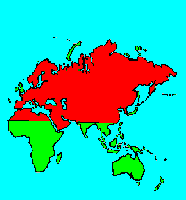SPECIES INFO
Nuphar luteum is found in Eurasia, northern Africa, and in Florida, Georgia, and Texas in North America. The Carolina flora notes that there are two subspecies found in the Carolinas. The ssp macrophylla has a leaf length to width ratio less than 3 (rounded). The ssp sagittifolia has a leaf length to width ratio greater than 3(elongate). They note the ssp sagittifolia is found in the coastal plain.Nuphar genus (yellow pond lily) is native to the temperate regions of the Northern Hemisphere. There are about 25 worldwide perennial aquatic herbs in this genus. They have large floating cordate-shaped leaves and yellow flowers. Until recently, various North American forms were given full species status. However, these forms were later combined into a single species. Consequently, as of 1994 there was only one species (Nuphar lutea) with seven subspecies found in North America. The subspecies as listed in 1994 in Kartesz are as follows: advena, orbiculara, polysepala, pumila, sagittifolia, ulvacea, and variegata. However, they were retained here as different species based on older literature and also on our personal observations.
The National Wildlife Federation Field Guide by Bradenburg published in 2010 notes that there are 8 native species in this genus in North America. They observe that the Nuphar polysepala lifeform is found in the northern Pacific Coast region. The observe that N. advena is found from southern New England to Illinois to Texas and Florida. They further observe that Nuphar variegata is found from northern New England west to Wisconsin and Minnesota, and sparingly further west.
There are two genera of great interest in the North American water lilies group. The typical many petaled species are in the genus Nymphaea which can be white or blue flowered and the smaller cup shaped yellow flowered kinds are in the genus Nuphar.
Water Lily Family (Nymphaceaceae) are naturally found from Alaska to Argentina, but are absent from western South America from Peru to Chile. These are also naturally found widely in the Old World, but are absent from desert northern Africa and almost absent from Australia. These are a distinctive group of plants usually characterized by larger floating leaves and large exotic flowers. The 90 species are limited to freshwater and most regions of the earth have their representative species. The water lily family has two genera with 13 species growing in greater North America.
Recently, the Nelumbo genus containing two species of lotus water lilies, previously placed here, has been moved elsewhere. (Perhaps to the Proteales in the Nelumbonaceae as its own family.) Furthermore, some experts want to move the Nuphar genus into a separate family. These issues are important to taxonomists, as most agree this family is important to an understanding of the early flowering plants.
Ranales Order has been broken down into nineteen different families. The water lilies, buttercups, magnolias, and other groups are included in this order. Large pretty flowers seem to be a common characteristic of this order.
The families in this order are in the process of a major re-location. The water lily family (Nymphaeaceae) appears to be an ancient family of plants, and its proper place is open to question. The hornwort (Ceratophyllaceae) family also appears to be a very ancient family, and probably does not belong here either.
Furthermore, the magnolia family (Magnoliaceae) and the buttercup family (Ranunculaceae)are not as closely related to each other as previously presumed, and that is an incentive to further dividing this order.
Until this organization is finalized, we are temporarily retaining this older order.
Dicots (Dicotyledoneae Class) are the predominant group of vascular plants on earth. With the exception of the grasses (Monocots) and the Conifers (Gymnosperms), most of the larger plants that one encounters are Dicots. Dicots are characterized by having a seed with two outer shell coverings.
Some of the more primitive Dicots are the typical hardwood trees (oaks, birches, hickories, etc). The more advanced Dicots include many of the Composite (Aster) Family flowers like the Dandelion, Aster, Thistles, and Sunflowers. Although many Monocots reach a very high degree of specialization, most botanists feel that the Dicots represent the most advanced group of plants.
Seed plants (Phylum Embryophyta) are generally grouped into one large phylum containing three major classes: the Gymnosperms, the Monocots, and the Dicots. (Some scientists separate the Gymnosperms into a separate phylum and refer to the remaining plants as flowering plants or Angiospermae.)
For North American counts of the number of species in each genus and family, the primary reference has been John T. Kartesz, author of A Synonymized Checklist of the Vascular Flora of the United States, Canada, and Greenland (1994). The geographical scope of his lists include, as part of greater North America, Hawaii, Alaska, Greenland, Puerto Rico, and the Virgin Islands.
Kartesz lists 21,757 species of vascular plants comprising the ferns, gymnosperms and flowering plants as being found in greater North America (including Alaska, Hawaii, Greenland, Puerto Rico and the Virgin Islands.
There are estimates within the scientific world that about half of the listed North American seed plants were originally native with the balance being comprised of Eurasian and tropical plants that have become established.
Plant kingdom contains a large variety of different organisms including mosses, ferns, and seed plants. Most plants manufacture their energy from sunlight and water. Identification of many species is difficult in that most individual plants have characteristics that have variables based on soil moisture, soil chemistry, and sunlight.
Because of the difficulty in learning and identifying different plant groups, specialists have emerged that study only a limited group of plants. These specialists revise the taxonomy and give us detailed descriptions and ranges of the various species. Their results are published in technical journals and written with highly specialized words that apply to a specific group.
On the other hand, there are the nature publishers. These people and companies undertake the challenging task of trying to provide easy to use pictures and descriptions to identify those species.




